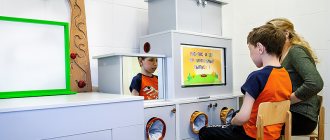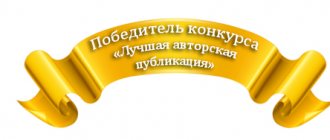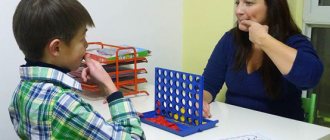The purpose and objectives of educational work in a speech therapy group
Educational work in a speech therapy group differs from educational work in a regular preschool group in that it is interconnected with correctional activities that are organized with children with various speech disorders.
In addition, children of the logogroup quite often, in addition to speech deviations, also have minor developmental deviations. Based on these characteristics, educational work should be built. Note 1
The goal of educational work in the speech therapy group: comprehensive and complete development of preschool children, taking into account their age and individual capabilities and needs.
Objectives of educational work:
Are you an expert in this subject area? We invite you to become the author of the Directory Working Conditions
- Children's assimilation of generally accepted rules and norms of behavior.
- Achieving stable results in mastering the general education program.
- Formation of moral and aesthetic qualities of the individual.
- Developing skills to maintain and strengthen one’s own health and the need for a healthy lifestyle.
- Formation of stable communication skills for successful interaction with others.
- Organization of an effective subject-development environment that promotes the overall development and personality development of preschool children, as well as the full development of speech.
Achieving the set goals and objectives of educational work in the logogroup is carried out through the professional activities of the teacher. That is why it is important that all teachers working with children constantly improve their knowledge and skills by studying pedagogical and methodological literature, attending advanced training courses and familiarizing themselves with the practical experience of their colleagues.
Under the guidance of a speech therapist - the principle of successful speech development
Only a speech therapist can solve a problem with pronunciation in a comprehensive manner.
Caring parents, trying to save their child from possible complications at school, begin to work with him on speech development. A properly designed exercise program and competent work methodology will bring tangible results in two directions :
- Active expansion of the lexicon , the child becomes aware of the peculiarities of the composition of words of different parts of speech;
- Improving oral speech , which, in turn, mobilizes the areas of the brain responsible for thinking, memory, alertness, concentration and reaction.
However, maximum results can only be achieved in suitable living and learning conditions. And for this it is necessary to provide the child, especially if he suffers from speech impairment, with classes with a speech therapist.
A school speech therapist deals with problems in the field of speech defects, correction and prevention of speech disorders, and has knowledge from various fields of pedagogy, humanities, exact and natural sciences related to speech and medicine, psychology, neurolinguistics and other related disciplines. Classes and consultations with a speech therapist will help to competently and timely diagnose the disorder, create a set of necessary exercises aimed at correcting and further eliminating problems in pronunciation .
At the same time, the work of a speech therapist in school is not limited to solving specific problems of correcting specific violations in individual students. Its main goal is to systematically identify children with speech impediments from the stream of students.
Technologies of educational work
Technologies of educational work in a speech therapy group:
Finished works on a similar topic
Course work Educational work in speech therapy groups 450 ₽ Abstract Educational work in speech therapy groups 260 ₽ Test work Educational work in speech therapy groups 240 ₽
Receive completed work or specialist advice on your educational project Find out the cost
- Gaming technologies are aimed at developing children's imagination, memory, attention, and speech. During the game, children have the opportunity to “assume” various roles, thereby learning to build relationships with other children and interact in a team. Gaming technologies are one of the most effective educational tools, since play for preschool children is the leading activity.
- The technology of integrated classes is a complex of different classes combined into one on equal terms. Integrated educational activities contribute to the development of children's moral qualities, aesthetic feelings, spiritual and moral sphere, creative potential, etc. That is, classes of this plan allow the teacher to significantly save time and at the same time obtain high educational results.
- Computer technologies are one of the most effective ways to increase motivation and individualize the educational process. When using computer technologies in educational work, the teacher is given a unique opportunity to create an interesting and educational lesson, a favorable emotional background and the all-round development of children. Classes using ICT are always interesting and exciting, and therefore the effectiveness of the educational impact on children is much higher.
The educational work in the speech therapy group firmly includes correctional classes on speech development. This is due to the fact that the development of speech in such a group is the leading direction that “permeates” all educational activities. Based on this, educational work is carried out not only in its “pure form”, but also in the process of implementing correctional classes on speech development, as well as at special moments.
The organization of educational work in a speech therapy group is carried out in the following forms:
- Group – work with several children, having a specific goal set based on the existing educational problems of these children.
- Individual – aimed at working with a specific child, based on his age characteristics and educational needs.
- Collective – work with the whole group, taking into account the characteristics of this category of children.
Methods and techniques of educational work in the logogroup:
- reproductive method: exercises, demonstration, explanations;
- verbal methods: conversations, riddles, reading, poetry, etc.;
- partial search methods: observation, examination, experimentation, research, etc.;
- project method: work on projects (short-term, long-term);
- a variety of techniques aimed at creating situations of success.
Speech therapy is the science of speech disorders, methods of their prevention, identification and elimination by means of special training and education, which studies: the causes, mechanisms, symptoms of speech disorders, course, structure. The term “Speech Therapy” consists of two Greek words: “Logos” - word, “Paideo” - educate.
On the basis of speech and its semantic unit - words, mental processes such as perception, imagination, memory are formed and developed. L. S. Vygotsky repeatedly pointed out that the development of oral speech is probably the most convenient phenomenon in order to trace the mechanism of behavior formation and compare the typical approach to thinking and personality formation for the study of conditioned reflexes with the psychological approach to them. The development of speech represents, first of all, the history of how one of the most important functions of a child’s cultural behavior is formed, which lies at the basis of the accumulation of his cultural experience.
Speech therapy assistance is a type of medical and pedagogical assistance provided to persons suffering from speech disorders of functional or organic origin (dyslalia, logoneurosis, aphasia, dysarthria, etc.). Timely therapeutic and corrective measures can accelerate the development of speech in children or eliminate acquired speech disorders in adults, and prevent secondary changes in intelligence caused by speech disorders.
The first special preschool institutions in our country were nurseries for children who stutter, where work was carried out under the methodological guidance of E.F. Pay (1932), and a semi-hospital speech therapy facility for stuttering preschoolers, organized on the initiative of the famous psychiatrist and public figure V.A. Gilyarovsky (1930). It used the one developed by Professor N.A. Vlasov’s comprehensive method of overcoming stuttering in children.
For a long time (60s), speech therapy assistance to children with other speech defects (dyslalia, dysarthria, alalia, etc.) was provided only in experimental groups or on an outpatient basis in children's clinics, which did not fully meet the needs of the population and did not provide full correction of speech disorders by the time the child enters school.
The subsequent period is characterized by a deep, comprehensive study of various forms of speech pathology in children of preschool and school age. It ended with the creation of a pedagogical classification of speech disorders. Based on a scientifically developed typology of children with speech defects, it became possible to substantiate the development of a differentiated network of preschool institutions for persons with various forms of speech disorders.
In the 70s intensive development of a specialized network began
Currently, in light of the implementation of the Federal State Standard for Preschool Education (clause 2.11.2), correctional work is aimed at ensuring the correction of developmental disorders of various categories of children who have the status of children with disabilities. The pupil’s diversified development is carried out taking into account age and individual characteristics, special educational needs and social adaptation.
In order to carry out correctional work, a speech therapy center operates on the basis of our preschool educational organization, which provides an individualized and systematic approach to the correction of speech disorders.
A speech therapist working at a speech center in an inclusive education setting, taking into account the specifics of the child’s defect, works in close collaboration with other specialists of the institution (music and physical education directors, doctors), parents and group teachers, regularly informs them about certain problems that arise in the process of correctional education. work.
At the present stage, speech therapy centers, in which speech therapy work is carried out by a specialist in eliminating speech disorders in preschool children, at mass general education kindergartens, are being reduced, which does not make it possible to cover a much larger contingent of children with speech therapy examination. To ensure efficient spending of budget funds, it is planned to merge speech therapy kindergartens with general developmental kindergartens; accordingly, there is a reduction in the staffing of speech therapist teachers. However, despite these difficulties, our city still has speech therapy centers and groups where speech therapy work is carried out with children with speech disorders. We propose to consider the concept of “speech therapy work” - this is an activity that, in parallel with the educational process, contributes to a more accessible and successful mastery of certain categories of children.
The goal of speech therapy work is the early identification and overcoming of deviations in the development of oral speech in preschool children.
The tasks that a speech therapist implements during his work in a general education kindergarten:
- diagnostics of children's speech development;
- social adaptation of children in a team;
- formation of communication abilities;
- developing the ability to collaborate;
- implementation of the necessary correction of speech disorders in children;
- creation of a developing subject-spatial environment and conditions for enriched, varied activities of children;
- determination and implementation of an individual route for correction and compensation of a speech defect, taking into account its structure, conditionality, as well as the individual personal characteristics of children;
- organizing the interaction of all subjects of the correctional educational process in implementing an integrated approach to the rehabilitation of children with speech development problems;
- interaction with the families of pupils to ensure the full, harmonious development of children, developing a competent pedagogical position in relation to their own child.
The principles of speech therapy work mean the starting points that determine the joint work of the speech therapist and the child in speech correction.
Currently, the basic principles of speech therapy work are identified, these include:
- The principle of systematicity takes into account the structures of various defects, determines the leading violation and correlates primary and secondary defects. Speech is a complex mental process, therefore, even if its individual links are disrupted, as a rule, all speech activity as a whole is disrupted. This determines a systematic approach to eliminating speech disorders.
- The principle of a differentiated approach is carried out taking into account the etiology of the disorder, symptoms, structure of speech defects, individual and age characteristics of the child. In the process of speech therapy work, it is important to take into account the level of speech development, characteristics of mental processes, and the level of cognitive activity.
- The principle of phasing is a complex process of speech therapy intervention, i.e., correction of deficiencies occurs in several stages. Each stage has its own tasks, methods and techniques for correction. There is a gradual transition from one stage to the next - from simpler to more complex.
- The ontogenetic principle, i.e. the speech therapist must take into account the development of speech in ontogenesis, from simple to complex. Sounds in a child’s speech need to be corrected in the same sequence in which they appeared during the child’s development.
- The principle of natural speech communication presupposes various situations in which the child finds himself. The child’s environment should be informed about the type of defect, tasks, methods of work and work closely with the speech therapist.
Having examined the concept of speech therapy assistance, and having studied the main goals, objectives and principles of work of a speech therapist in a general preschool educational institution, we will move on to the next section, devoted to the methods of work of a speech therapist with children in a preschool institution.
A method is a systematized set of steps and actions that are aimed at solving a specific problem or achieving a specific goal.
Speech therapy intervention is a pedagogical process, the main forms of which are education, training, correction, compensation, adaptation, rehabilitation. Speech therapy intervention is carried out in the following forms of training: frontal, subgroup, lesson, individual lesson.
Impact is the active influence of a subject on an object, not necessarily explicit or with feedback. Speech therapy intervention is carried out using various methods: practical, visual, verbal.
The choice and use of one or another method is determined by the nature of the speech disorder, the content, goals and objectives of correctional speech therapy, the stage of work, the age, individual psychological characteristics of the child, etc. At each stage of speech therapy work, the effectiveness of mastering correct speech skills is ensured by the corresponding group of methods . Thus, the stage of sound production is characterized by the predominant use of practical and visual methods; When automating, especially in connected speech, conversation, retelling, story, i.e., verbal methods are widely used.
When eliminating stuttering in preschool age, the effectiveness of speech therapy work is achieved by practical and visual methods.
1. Practical methods of speech therapy include exercises, games and modeling.
- Exercise is the child’s repeated repetition of practical and mental actions.
- Game, as a method, involves a combination of various components of gaming activity with other techniques: demonstration, explanation, instructions, questions.
- Modeling, as a method of speech therapy intervention, is the process of creating models and using them to form ideas about the structure of objects, the relationships and connections between the elements of these objects.
2. Visual methods are those forms of assimilation of knowledge, skills and abilities that are significantly dependent on the visual aids and technical means of teaching speech therapy influences on individual speech disorders used in teaching.
Visual methods include observations, looking at drawings, paintings, models, watching videos, listening to audio recordings, as well as showing a sample task, a method of action, which in some cases act as independent methods.
3. Features of the use of verbal methods in speech therapy work are determined by the age characteristics of the children, the structure and nature of the speech defect, goals, objectives, and the stage of correctional intervention. When working with preschool children, verbal methods are combined with practical and visual ones. The main verbal methods are story, conversation, reading.
- A story is a form of teaching in which the presentation is descriptive.
- Conversation is a method of obtaining information based on verbal communication.
- Reading is a complex cognitive process of symbol decoding aimed at understanding text.
When assessing a child’s activity, it is necessary to take into account his age and individual psychological characteristics. Unconfident, shy, and acutely aware of their defects should be more often encouraged to show pedagogical tact when assessing their work.
Thus, we reviewed the main sections of this topic. The above information has been studied and analyzed in comparison of theory and practice. Preschool educational institutions and speech centers for children with speech disorders are the first stage of lifelong education and are part of the public preschool education system. Correctional speech therapy work in preschool institutions plays a leading role in the education and development of preschool children if they have speech underdevelopment and secondary psychological deviations in overcoming and compensating them.







